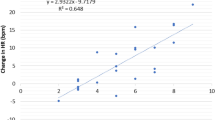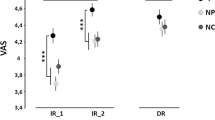Abstract
In research involving the cold pressor test, a tacit presumption is often made that reporting pain during stimulation is not in itself reactive. This study examined whether, for the foot and forehead cold pressor tests, activities involved in reporting pain may affect (a) the evoked pattern of cardiovascular response, and (b) the magnitude of self-perceived pain. In 40 normotensive college men, increases in systolic blood pressure were greater during test sessions that included verbal ratings of pain, as compared to sessions in which pain was not reported. In contrast to its effect on physiological activation, reporting pain did not significantly alter the participant’s perception of the painfulness of the test, on recollection shortly after the test. We conclude, therefore, that reporting pain during the cold pressor test may impose significant additional demands on the cardiovascular system, but it docs not interfere significantly with the processing of nociceptive information.
Similar content being viewed by others
References
Beidel, D. C., Turner, S. M., & Dancu, C. (1985). Physiological, cognitive and behavioral aspects of social anxiety.Behavioral Research and Therapy, 23, 109–117.
Bolli, P., Amann, F. W., Hulthen, L., Kiowski, W., & Buhler, F. R. (1981). Elevated plasma adrenaline reflecl sympathetic overactivity and enhanced alpha-adrenoceptor-mediated vasoconstriction in essential hypertension.Clinical Science, 61(Suppl.), 161–164.
Bullinger, M., Naher, D., Pickar, D., Cohen, R. M., Kalin, N. H., Pert, A., & Bunney, W. E. (1984). Endocrine effects of the cold pressortest: Relationship to subjective pain appraisal and coping.Psychiatry Research, 12, 227–233.
Chen, A. C., Dworkin, S. F., Haug, J., & Gehrig, J. (1989). Topographic brain measures of human pain and pain responsivity.Pain, 37, 129–141.
DeQuatlro, V., & De-Ping Lee, D. (1989). Physical stressors and pharmacologic manipulation. In N. Schneiderman, S. M. Weiss, & P. G. Kaufmann (Eds.),Handbook of research methods in cardiovascular behavioral medicine (pp. 402–404). New York: Plenum.
Durel, L. A., Kus, L. A., Anderson, N. B., McNelly, M., Llabre, M. M., Spitzer, S., Saab, P. G., Efland, J., Williams, R., & Schneiderman, N. (1993). Patterns and stability of cardiovascular responses to variations of the cold pressor test.Psychophysiology, 30, 39–46.
Hilgard, E., Ruch, J., Lange, A., Lenox, J., Morgan, A., & Sachs, L. (1974). The psychophysics of cold pressor pain and its modification through hypnotic suggestion.American Journal of Consulting and Clinical Psychology, 35, 148–152.
Hurwitz, B. E., Shyu, L. Y., Reddy, S. P., Schneiderman, N., & Nagel, J. H. (1990). Coherent ensemble averaging techniques for impedance cardiography. In H. T. Nagle & J. N. Brown (Eds.).Computer-based medical systems (pp. 228–235). Washington, DC: IEEE Computer Society Press.
Lovallo, W., Pincomb, G. A., & Wilson, M. F. (1986). Heart rate reactivity and Type A behavior as modifiers of physiological response to active and passive coping.Psychophysiology, 23, 105–112.
McCalla, J. R., Saab, P. G., Llabre, M. M., & Schneiderman, N. (1992, March).Cardiovascular responses to mental arithmetic tasks in young adult men and women. Paper presented at the annual meeting of the Society of Behavioral Medicine. New York.
Mikail, S. I., Vandeursin, J., & von Baeyer, C. (1986). Rating pain or rating serenity: Effects on cold-pressor pain tolerance.Canadian Journal of Behavioral Science, 18, 122–132.
Myrtek, M., & Spital, S. (1986). Psychophysiological response patterns to single, double, and triple stressors.Psychophysiology, 23, 663–671.
Nagel, J. H., Shyu, L. Y., Reddy, S. P., Hurwitz, B. E., McCabe, P. M., & Schneiderman, N. (1989). New signal processing techniques for improved precision of noninvasive impedance cardiography.Annals of Biomedical Engineering, 17, 517–534.
Paulev,P., Pokorski, M., Honda, Y., Ahn, B.,Masuda, A., Kobayashi,T., Nishibayashi, Y., Sakakibara, Y., Tanaka, M., & Nakamura, W. (1990). Facial cold receptors and the survival reflex “diving bradycardia” in man.Japanese Journal of Physiology, 40, 701–712.
Peckerman, A., Hurwitz, B., Saab, P. G., Llabre, M. M., McCabe, P. M., & Schneiderman, N. (1994). Stimulus components of thc cold pressor test and associated patterns of cardiovascular response.Psychophysiology, 31, 282–290.
Peckerman, A., Saab, P. G., McCabe, P. M., Skyler, J. S., Winters, R. W., Llabre, M. M., & Schneidennan, N, (1991). Blood pressure reactivity and perception of pain during the forehead cold pressor test.Psychophysiology, 28, 485–495.
Pedhazur, E. J. (1982).Multiple regression in behavioral research (pp. 247–251). New York: Holt, Rinehart & Winston.
Saab, P. G., Llabre, M. M., Hurwitz, B.E., Schneiderman, N. Wohlgemuth, W., Durel, L. A., Massie, C., & Nagel, J. (1993). The cold pressor lest: Vascular and myocardial response patterns and their stability.Psychophysiology, 30, 366–373.
Schneiderman, N., & McCabe, P. M. (1989). Psychophysiologic strategies in laboratory research. In N. Schneiderman, S. M. Weiss, & P. G. Kaufmann (Eds.),Handbook of research methods in cardiovascular behavioral medicine (pp. 349–364), New York: Plenum.
Sherwood, A., Allen, M. T., Obrist, P. A., & Langer, A. W. (1986). Evaluation of beta-adrenergic influences on cardiovascular and metabolic adjustments to physical and psychological stress.Psychophysiology, 23, 89–104.
Wolf, S., & Hardy, J. D. (1941). Studies on pain. Observations on pain due to local cooling and on factors involved in the “cold pressor” effect.Journal of Clinical Investigation, 20, 521–533.
Wolff, B. B. (1984). Methods of testing pain mechanisms in normal man. In P. D. Wall & R. Melzack (Eds.).Textbook of pain (pp. 196–184). Edinburgh, Scotland: Churchill Livingstone.
Author information
Authors and Affiliations
Additional information
This research was supported by Grants HL 07426 and HL 36588 from the National Heart, Lung and Blood Institute of the National Institutes of Health
Rights and permissions
About this article
Cite this article
Peckerman, A., Saab, P.G., Llabre, M.M. et al. Cardiovascular and perceptual effects of reporting pain during the foot and forehead cold pressor tests. Int. J. Behav. Med. 5, 106–117 (1998). https://doi.org/10.1207/s15327558ijbm0502_2
Issue Date:
DOI: https://doi.org/10.1207/s15327558ijbm0502_2




